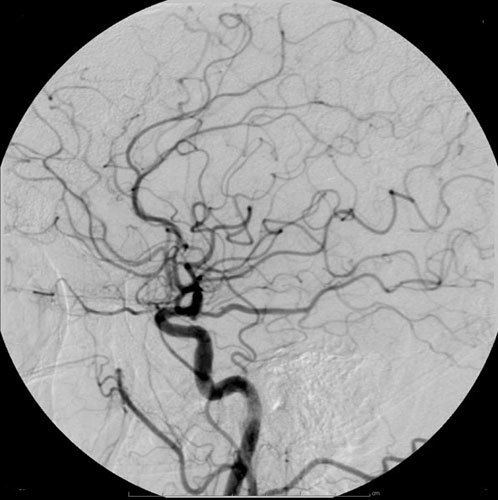MeSH D015901 | ||
 | ||
Digital subtraction angiography (DSA) is a type of fluoroscopy technique used in interventional radiology to clearly visualize blood vessels in a bony or dense soft tissue environment. Images are produced using contrast medium by subtracting a 'pre-contrast image' or the mask from later images, once the contrast medium has been introduced into a structure. Hence the term 'digital subtraction angiography'. Subtraction angiography was first described in 1935 and in English sources in 1962 as a manual technique. Digital technology made DSA practical from the 1970s.
Contents
DSA and fluoroscopy
In traditional angiography, images are acquired by exposing an area of interest with time-controlled x-rays while injecting contrast medium into the blood vessels. The image obtained would also include all overlying structure besides the blood vessels in this area. This is useful for determining anatomical position and variations but unhelpful for visualizing blood vessels accurately.
In order to remove these distracting structures to see the vessels better, first a mask image is acquired. The mask image is simply an image of the same area before the contrast is administered. The radiological equipment used to capture this is usually an image intensifier, which will then keep producing images of the same area at a set rate (1–6 frames per second), taking all subsequent images away from the original 'mask' image. The radiologist controls how much contrast media is injected and for how long. Smaller structures require less contrast to fill the vessel than others. Images produced appear with a very pale grey background, which produces a high contrast to the blood vessels, which appear a very dark grey.
The images are all produced in real time by the computer, as the contrast is injected into the blood vessels.
Intravenous digital subtraction angiography
Intravenous digital subtraction angiography (IV-DSA) is a form of angiography which was first developed in the late 1970s.
IV-DSA uses a computer technique which compares an x-ray image of a region of the body before and after radiopaque iodine based dye has been injected intravenously into the body. Tissues and blood vessels on the first image are digitally subtracted from the second image, leaving a clear picture of the artery which can then be studied independently and in isolation from the rest of the body.
Some limited studies have indicated that IV-DSA is not suitable for patients with diabetes or renal insufficiency because the dye load is significantly higher than is used in arteriography. However, IV-DSA has been used successfully to study the vessels of the brain and heart and has helped detect carotid artery obstruction and to map patterns of cerebral blood flow. It also helps detect and diagnose lesions in the carotid arteries which is a potential cause of strokes.
IV-DSA has also been useful in assessing patients prior to surgery and after coronary artery bypass surgery and some transplant operations.
Applications
DSA is primarily used to image blood vessels. It is useful in the diagnosis and treatment of:
The future
DSA is being used less and less routinely in imaging departments. It is being replaced by computed tomography angiography (CTA), which can produce 3D images through a test which is less invasive and stressful for the patient, and magnetic resonance angiography (MRA), which avoids ionizing radiation and nephrotoxic contrast agents.
